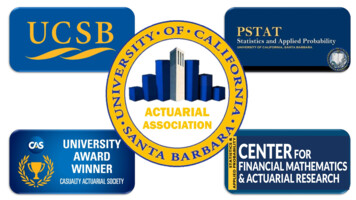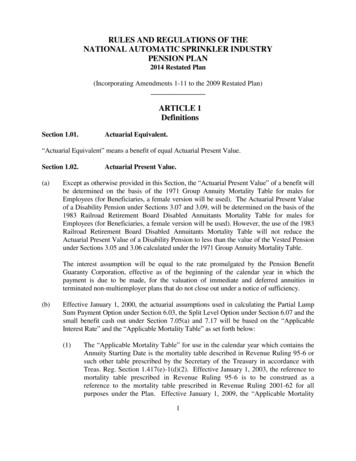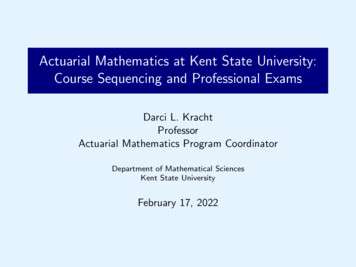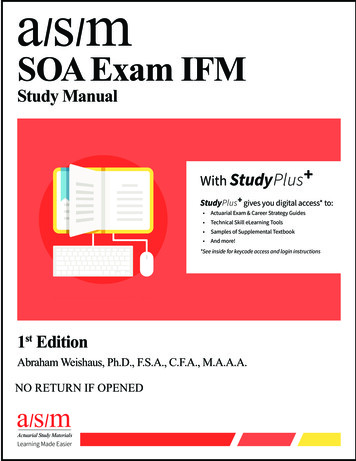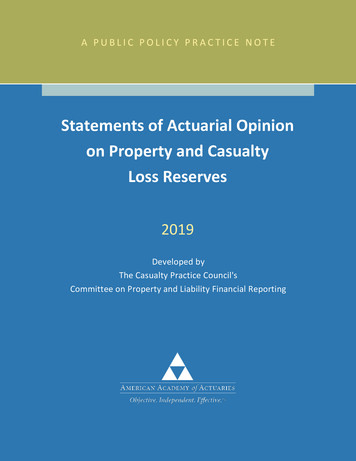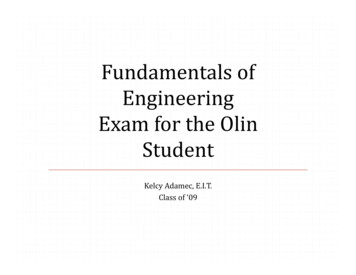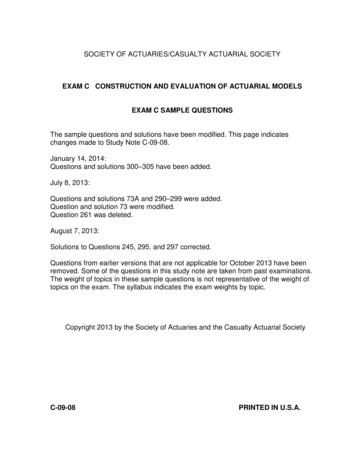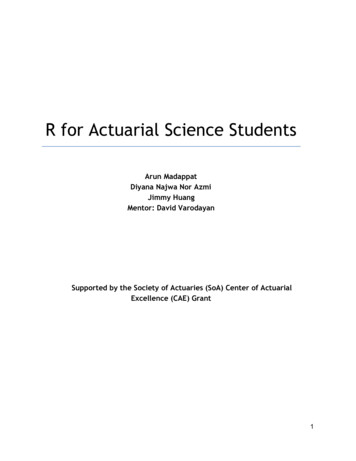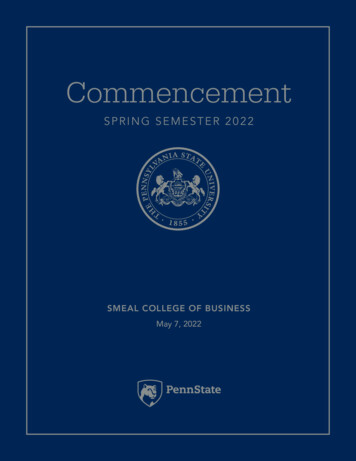
Transcription
Fundamentals of Actuarial Mathematics Exam – Draft Syllabus– December 2021 DraftThe following is a draft syllabus for the new Exam FAM, to be first offered in October 2022. This 3.5-hourexam consists of 40 multiple-choice questions and is administered as a computer-based test (CBT). Foradditional details on CBT, please refer to Exam Rules. It is possible that there will be small changes to thissyllabus when the final version is released, which will be at least six months in advance of the exam. Inparticular, there may be adjustments to the percentage weights and the assigned readings.Fundamentals of Actuarial Mathematics1
LEARNING OUTCOMES – SHORT-TERM (FAM-S)1. Topic: Insurance and Reinsurance Coverages (5-7.5%)Learning ObjectivesThe Candidate will understand the key features of insurance and reinsurance coverages.Learning OutcomesThe Candidate will be able to:a) Define and apply the concept of insurable risk.b) Identify different types of short-term insurance coverage including auto, homeowners,liability, health, disability, and workers compensation.c) Identify the types and determine the impact of policy limits and coverage modifications forshort-term insurance.d) Identify the different forms of individual risk rating plans.e) Identify the operation of basic forms of proportional and excess of loss reinsurance andunderstand their impact on reserving and pricing.f)Determine the allocation of claim amounts paid by the insurer and reinsurer under variousforms of reinsurance.Fundamentals of Actuarial Mathematics2
2. Topic: Severity, Frequency, and Aggregate Models (10-17.5%)Learning ObjectivesThe Candidate will understand the characteristics of and uses for commonly used severity, frequency,and aggregate models.Learning OutcomesThe Candidate will be able to:a) For severity models: Calculate moments and percentiles. Identify the role of scale and shape parameters in continuous models. Recognize classes of distributions and their relationships. Characterize distributions by existence of moments.b) For frequency models: Identify the role of parameters for the (a,b,0) class of distributions. Recognize the (a,b,0) class of distributions and their relationships. Perform calculations for the (a,b,0) class of distributions. Identify appropriate distributions for a given application.c) For aggregate models: Define collective and individual risk models and calculate their mean and variance. Use the log-normal or normal approximation to approximate the aggregate distribution.d) For risk measures: Calculate Value at Risk and Tail Value at Risk. Determine whether a given risk measure has certain desirable properties.Fundamentals of Actuarial Mathematics3
3. Topic: Parametric Estimation (10-15%)Learning ObjectivesThe Candidate will understand and be able to estimate parameters for parametric models.Learning OutcomesThe Candidate will be able to:a) Estimate the parameters for severity, frequency, and aggregate distributions using MaximumLikelihood Estimation for: Complete, individual data Complete, grouped data Truncated or censored data4. Topic: Introduction to Credibility (5-7.5%)Learning ObjectivesThe Candidate will understand the concepts of credibility and be able to apply certain types ofcredibility in some practical settings.Learning OutcomesThe Candidate will be able to:a) Understand the concept of credibility.b) Perform calculations using limited fluctuation (classical) credibility.Fundamentals of Actuarial Mathematics4
5. Topic: Pricing and Reserving for Short-Term Insurance Coverages (10-12.5%)Learning ObjectivesThe Candidate will be able to use basic methods to calculate premiums and reserves for short-terminsurance coverages.Learning OutcomesThe Candidate will be able to:a) Describe and apply techniques for estimating outstanding claims, using the followingmethods: Expected Loss Ratio Chain-Ladder Bornhuetter-Fergusonb) Understand the objectives of ratemaking and the data used for ratemaking.c) Calculate the adjustments to ratemaking data, including development, trend and adjustingpremium to current rate levels.d) Understand how expenses and the profit and contingencies loading are used in ratemaking.e) Calculate overall average rates and rate changes using the loss cost and loss ratio methods.Fundamentals of Actuarial Mathematics5
LEARNING OUTCOMES – LONG-TERM (FAM-L)6. Topic: Insurance Coverages and Retirement Financial Security Programs (2.5-5%)Learning ObjectivesThe Candidate will understand the key features of insurance coverages and retirement financialsecurity programs.Learning OutcomesThe Candidate will be able to:a) Define and apply the concept of insurable interest.b) Identify the long-term insurance coverages (life, health), annuities, and defined benefit anddefined contribution pension plans.7. Topic: Mortality Models (7.5-10%)Learning ObjectivesThe Candidate will understand key concepts concerning parametric and non-parametric mortalitymodels for individual lives.Learning OutcomesThe Candidate will be able to:a) Understand parametric survival models, life tables, and the relationships between them.b) Given a parametric survival model, calculate survival and mortality probabilities, the force ofmortality function, and curtate and complete moments of the future lifetime randomvariable.c) Identify and apply standard actuarial notation for future lifetime distributions and moments,including select and ultimate functions.d) Given a life table, calculate survival and mortality probabilities, the force of mortalityfunction, and curtate and complete moments of the future lifetime random variable, usingappropriate fractional age assumptions where necessary.e) Understand and apply select life tables.f)Identify common features of population mortality curves.g) Apply formula-based and spline-based deterministic mortality improvement factors, allowingfor calendar year and cohort year effects.Fundamentals of Actuarial Mathematics6
8. Topic: Survival Estimation (7.5-10%)Learning ObjectivesThe Candidate will understand and be able to estimate parameters for parametric and nonparametric survival models.Learning OutcomesThe Candidate will be able to:a) Estimate the parameters for survival models using Maximum Likelihood Estimation for: Complete, individual data Complete, grouped data Truncated or censored datab) Apply Kaplan Meier and Nelson Aalen methods to estimate empirical survival functionsusing censored and truncated lifetime data.c) Calculate approximate standard errors of the parameter/probability estimates.d) Construct linear and non-linear confidence intervals (as appropriate) forparameters/estimates.9. Topic: Present Value Random Variables for Long-Term Insurance Coverages (5-10%)Learning ObjectivesThe Candidate will be able to perform calculations on the present value random variables associatedwith benefits and expenses for long term insurance coverages.Learning OutcomesThe Candidate will be able to:a) Identify the present value random variables associated with life insurance, endowment, andannuity payments for single lives, based on annual, 1/m-thly and continuous paymentfrequency.b) Calculate probabilities, means, variances and covariances for the random variables in Topic9(a), using fractional age or claims acceleration approximations where appropriate.c) Understand the relationships between the insurance, endowment, and annuity present valuerandom variables in Topic 9(a), and between their expected values.d) Calculate the effect of changes in underlying assumptions (e.g., mortality and interest).e) Identify and apply standard actuarial notation for the expected values of the randomvariables in Topic 9(a).Fundamentals of Actuarial Mathematics7
10. Topic: Premium and Policy Value Calculation for Long-Term Insurance Coverages (10-15%)Learning ObjectivesThe Candidate will be able to use and explain the premium and policy value calculation processes forlong-term insurance coverages.Learning OutcomesThe Candidate will be able to:a) Identify the future loss random variables associated with whole life, term life, andendowment insurance, and with term and whole life annuities, on single lives.b) Calculate premiums based on the equivalence principle, the portfolio percentile principle, andfor a given expected present value of profit, for the policies in Topic 10(a).c) Calculate and interpret gross premium, net premium and modified net premium policy valuesfor the policies in Topic 10(a).d) Identify and apply Thiele’s differential equation, as applied to the policies in Topic 10(a).e) Calculate the effect of changes in underlying assumptions (e.g., mortality and interest).f)Apply the following methods for modelling extra risk: age rating; constant addition to theforce of mortality, constant multiple of the rate of mortality.Fundamentals of Actuarial Mathematics8
11. Topic: Option Pricing Fundamentals (7.5-10%)Learning ObjectivesThe Candidate will be able to value simple options and derivatives using risk neutral expected presentvalues, under the binomial and Black-Scholes models.Learning OutcomesThe Candidate will be able to:a) Identify the cash flows and characteristics of puts and calls.b) Apply the binomial option pricing model to calculate the price of a simple European-stylederivative on a single non-dividend paying asset.c) Apply the Black-Scholes formula to calculate the price and delta hedge of a simple Europeanstyle derivative on a single non-dividend paying asset.d) Apply put-call parity.Fundamentals of Actuarial Mathematics9
Readings - Short-Term (FAM-S):Loss Models:Chapter 3 (Sections 1, 2, 4.1, 5)Chapter 4Chapter 5 (Sections 3, 4)Chapter 6 (Section 5)Chapter 9 (Sections 1-3, 8.1, 8.2)Chapter 11 (Sections 1-4)Chapter 12 (Sections 1-3)Chapter 16Introduction to Ratemaking and Loss Reserving for Property and Casualty Insurance:Chapter 1Chapter 2Chapter 3 (Sections 1-6.4)Chapter 4 (Sections 1-8.1)Chapter 5 (Sections 2, 5)Individual Health Insurance (IHI):Chapter 2 (Sections 1, 9)Readings - Long-Term (FAM-L):Actuarial Mathematics for Life Contingent Risks:Chapter 1Chapter 2Chapter 3Chapter 4Chapter 5Chapter 6Chapter 7 (Sections 1-4 [except 2.4, 2.5], 7, 8)Chapter 16Chapter 18 (Sections 1-5)Fundamentals of Actuarial Mathematics10
Fundamentals of Actuarial Mathematics 1 . Fundamentals of Actuarial Mathematics Exam - Draft Syllabus - December 2021 Draft. The following is a draft syllabus for the new Exam FAM, to be first offered in October 2022. This 3.5-hour exam consists of 40 multiple-choice questions and is administered as a computer-based test (CBT). For
